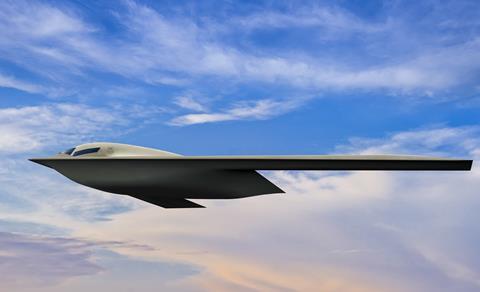Defence contractor Northrop Grumman beat earnings estimates for the first quarter of 2022 and predicts faster growth later in the year.
Chief executive Kathy Warden says the Virginia-based manufacturer was not materially impacted by pandemic-related headwinds that have created significant supply chain and labour challenges for rivals like Boeing.

Although the reported earnings of $955 million in the first three months of 2022 are a substantial decline from the $2.1 billion it logged in the same period last year, Northrop still beat expectations for the current period. Other players in the defence industry have reported similar year-over-year declines.
Executives at Northrop struck an optimistic tone during a 28 April earnings call, saying they are on track to meet annual revenue targets and expect sales to accelerate in the second half of 2022.
Warden is particularly optimistic about the future impact of the B-21 Raider programme. The Raider is a next-generation, nuclear-capable, long-range strategic bomber being developed by Northrop for the US Air Force (USAF).
Little is known about the secretive aircraft, other than it is intended to penetrate anti-access/area-denial air defences to launch precision strikes with either conventional or nuclear bombs.
The sky is the limit for the Raider programme, according to Northrop leaders. On the 28 April earnings call, chief financial officer David Keffer revealed that the company received a $67 million incentive payment from the US government tied to performance on the project.
He also notes that the fiscal year 2023 proposed defence budget from the Biden administration marks the first time funds were requested for B-21 procurement, rather than for just research and development.
Warden says the first B-21 is now undergoing ground testing with the USAF, with test flights expected to follow. Five additional test aircraft are in various stages of development.
The B-21 is expected to enter limited production next year. During that period, the government will purchase individual aircraft at contractually set prices. When the programme ultimately enters full production, Northrop and the USAF will negotiate a final per-unit price for B-21s.
Warden notes this provides a hedge against inflationary pressure in the supply chain.
The new stealth bomber is a major pillar of Northrop’s defence business strategy, with executives projecting “robust funding” for the programme in years to come, although Warden notes that specifics on the procurement plan remain classified.
The B-21 represents one leg of the USA’s so-called “nuclear triad” of bombers, submarines and land-based ballistic missiles – all being capable of launching nuclear strikes. Northrop is also under contract to develop the next generation of ground-based intercontinental ballistic missiles (ICBM) for the USAF, which replace the long-serving Minuteman III ICBM.
The company also expects to see solid earnings from its various roles in the production of Lockheed Martin F-35 Joint Strike Fighters and from sales of its E-2D Hawkeye aerial command and control aircraft.
Northrop says the E-2 programme will be dependent on foreign sales for revenue after 2025, but notes there is already strong interest overseas.
Correction: Story changed on 10 June to remove incorrect dates for production and initial operating capacity of the B-21. A different Northrop Grumman programme, the Ground Based Strategic Deterent, will enter production in 2026 with IOC expected in 2029.


























